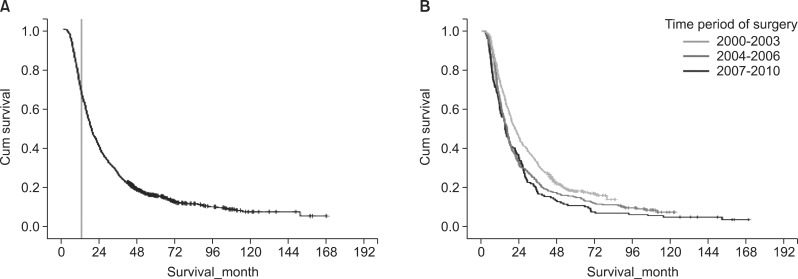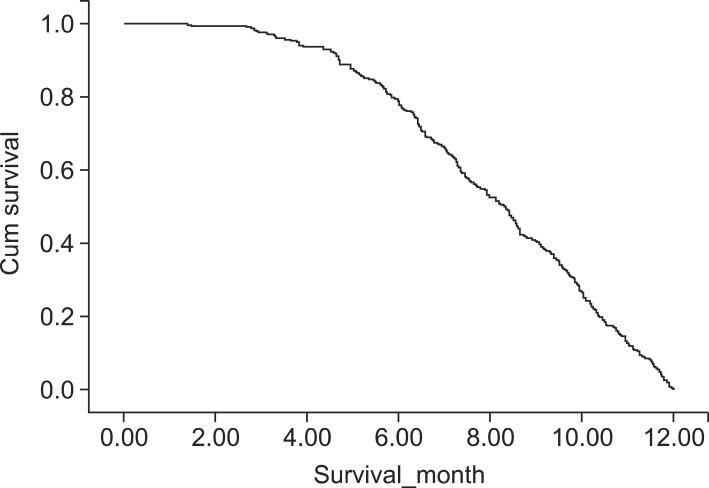Korean J Hepatobiliary Pancreat Surg.
2014 Nov;18(4):138-146. 10.14701/kjhbps.2014.18.4.138.
Prognostic factors associated with early mortality after surgical resection for pancreatic adenocarcinoma
- Affiliations
-
- 1Division of Hepatobiliary and Pancreatic Surgery, Department of Surgery, Asan Medical Center, University of Ulsan College of Medicine, Seoul, Korea. drksc@amc.seoul.kr
- KMID: 1802229
- DOI: http://doi.org/10.14701/kjhbps.2014.18.4.138
Abstract
- BACKGROUNDS/AIMS
Identifying pancreatic cancer patients at high risk of early mortality following surgical resection for pancreatic cancer is important to make optimal treatment decisions in multidisciplinary setting. The purpose of this study was to identify the factors related to early mortality in patients who underwent pancreatic resection for pancreatic adenocarcinoma.
METHODS
We reviewed our institution's experience with all consecutive patients who underwent pancreatectomy for pancreatic adenocarcinoma from January 2000 to December 2010. One thousand patients were eligible for our study. Fifty-three patients who did not meet the study criteria were excluded. Based on 12 months after surgery, patients were divided into early mortality group or the remaining group. We performed logistic regression analysis to identify predictors of early mortality.
RESULTS
Among 947 patients who met our study criteria, 302 (31.9%) early mortality (defined as experiencing death within 12 months after surgery) occurred. Multivariate analysis revealed that patient age and surgery time period were statistically significant predictors of early mortality within six months after surgery. Poorly differentiated tumor and adjuvant chemotherapy were statistically significant predictors of early mortality within 12 months after surgery. Total pancreatectomy and lymphovascular invasion were significant (p<0.05) prognostic factors of early mortality within 6 or 12 months after surgery.
CONCLUSIONS
We suggest followings to avoid early mortality after pancreatic resection: patients with multiple risk factors related to early mortality after pancreatectomy should be considered for alternative treatment; patient's general condition and surgical technique improvement are important; and adjuvant therapy should be taken into consideration.
Keyword
MeSH Terms
Figure
Reference
-
1. Kern S, Hruban R, Hollingsworth MA, Brand R, Adrian TE, Jaffee E, et al. A white paper: the product of a pancreas cancer think tank. Cancer Res. 2001; 61:4923–4932. PMID: 11406572.2. Bilimoria KY, Bentrem DJ, Ko CY, Ritchey J, Stewart AK, Winchester DP, et al. Validation of the 6th edition AJCC pancreatic cancer staging system: report from the National Cancer Database. Cancer. 2007; 110:738–744. PMID: 17580363.3. Jemal A, Siegel R, Ward E, Hao Y, Xu J, Murray T, et al. Cancer statistics, 2008. CA Cancer J Clin. 2008; 58:71–96. PMID: 18287387.
Article4. Baumel H, Huguier M, Manderscheid JC, Fabre JM, Houry S, Fagot H. Results of resection for cancer of the exocrine pancreas: a study from the French Association of Surgery. Br J Surg. 1994; 81:102–107. PMID: 7906180.
Article5. Sohn TA, Yeo CJ, Cameron JL, Koniaris L, Kaushal S, Abrams RA, et al. Resected adenocarcinoma of the pancreas-616 patients: results, outcomes, and prognostic indicators. J Gastrointest Surg. 2000; 4:567–579. PMID: 11307091.
Article6. Richter A, Niedergethmann M, Sturm JW, Lorenz D, Post S, Trede M. Long-term results of partial pancreaticoduodenectomy for ductal adenocarcinoma of the pancreatic head: 25-year experience. World J Surg. 2003; 27:324–329. PMID: 12607060.
Article7. Dalton RR, Sarr MG, van Heerden JA, Colby TV. Carcinoma of the body and tail of the pancreas: is curative resection justified? Surgery. 1992; 111:489–494. PMID: 1317976.8. Brennan MF, Moccia RD, Klimstra D. Management of adenocarcinoma of the body and tail of the pancreas. Ann Surg. 1996; 223:506–511. discussion 511-512. PMID: 8651741.
Article9. Magistrelli P, Antinori A, Crucitti A, La Greca A, Masetti R, Coppola R, et al. Prognostic factors after surgical resection for pancreatic carcinoma. J Surg Oncol. 2000; 74:36–40. PMID: 10861607.
Article10. Hsu CC, Wolfgang CL, Laheru DA, Pawlik TM, Swartz MJ, Winter JM, et al. Early mortality risk score: identification of poor outcomes following upfront surgery for resectable pancreatic cancer. J Gastrointest Surg. 2012; 16:753–761. PMID: 22311282.
Article11. Barugola G, Partelli S, Marcucci S, Sartori N, Capelli P, Bassi C, et al. Resectable pancreatic cancer: who really benefits from resection? Ann Surg Oncol. 2009; 16:3316–3322. PMID: 19707831.
Article12. Takamori H, Hiraoka T, Kanemitsu K, Tsuji T, Hamada C, Baba H. Identification of prognostic factors associated with early mortality after surgical resection for pancreatic cancer: under-analysis of cumulative survival curve. World J Surg. 2006; 30:213–218. PMID: 16425074.13. Kennedy EP, Yeo CJ. The case for routine use of adjuvant therapy in pancreatic cancer. J Surg Oncol. 2007; 95:597–603. PMID: 17230543.
Article14. Polterauer S, Grimm C, Seebacher V, Rahhal J, Tempfer C, Reinthaller A, et al. The inflammation-based Glasgow Prognostic Score predicts survival in patients with cervical cancer. Int J Gynecol Cancer. 2010; 20:1052–1057. PMID: 20683416.
Article15. Shimoda M, Katoh M, Kita J, Sawada T, Kubota K. The Glasgow prognostic score is a good predictor of treatment outcome in patients with unresectable pancreatic cancer. Chemotherapy. 2010; 56:501–506. PMID: 21099223.
Article16. Martin HL, Ohara K, Kiberu A, Van Hagen T, Davidson A, Khattak MA. Prognostic value of systemic inflammation-based markers in advanced pancreatic cancer. Intern Med J. 2014; 44:676–682. PMID: 24750233.
Article17. Shibata K, Matsumoto T, Yada K, Sasaki A, Ohta M, Kitano S. Factors predicting recurrence after resection of pancreatic ductal carcinoma. Pancreas. 2005; 31:69–73. PMID: 15968250.
Article18. Callery MP, Chang KJ, Fishman EK, Talamonti MS, William Traverso L, Linehan DC. Pretreatment assessment of resectable and borderline resectable pancreatic cancer: expert consensus statement. Ann Surg Oncol. 2009; 16:1727–1733. PMID: 19396496.
Article
- Full Text Links
- Actions
-
Cited
- CITED
-
- Close
- Share
- Similar articles
-
- Prognostic Factors and Survival Rate of Pancreatic Adenocarcinoma after Curative Surgery
- Stages and Prognostic Factors of Pancreatic Cancer after Resection
- Biliary Tract and Pancreas: Survival and Recurrence Pattern after Curative Resection of Pancreatic Cancer
- Factors affecting long-term survival after surgical resection of pancreatic ductal adenocarcinoma
- Surgical Treatment and Outcomes of Primary Duodenal Adenocarcinoma



